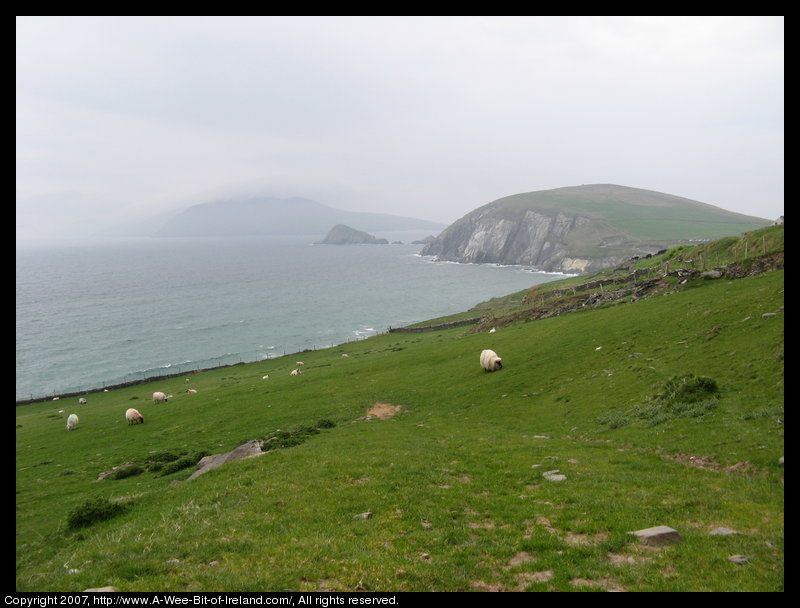Slea Head Scenic Drive in County Kerry
Dunmore Head (Dun Mór) and Great Blasket Island (An Blascaod Mór).
Next photo of Slea Head Scenic Drive. Previous photo of Slea Head Scenic Drive.

http://miris.eurac.edu/mugs2/do/blob.pdf?type=pdf&serial=1020330012830 retrieved 19 June 2021.The background setting to the enactment of An Blascaod Mór National Park Act, 1989
1. The Blasket Islands lie off the coast of the Dingle Peninsula in County Kerry. The seven islands and several islets and rocks are in the barony of Corca Dhuibhne on the north side of the entrance to Dingle Bay. As one looks out at the archipelago from Slea Head below Mount Eagle on the peninsula, Innisvickillane is to the south-west; Innisnabro to the west; and further west, behind the Great Blasket is Tiaracht, which has a lighthouse; to the north, lies Inis Tuaisceart; and off the east of the Great Blasket are Beiginis and Oiléan na nÓg. The Great Blasket, or An Blascaod Mór, is across the Blasket Sound from Slea Head and is a narrow island about five kilometres long by one kilometre wide. It is the largest of the islands with the remnants of a village behind the beach known as the White Strand or Trá Bán at the east end closest to the mainland. Although the island, at its closest point to the mainland, is only just more than one kilometre off Dun Mór Head, it is a sea journey of about five kilometres from the harbour at Dun Chaoin to the small breakwater below the village. The seas in the Blasket Sound can be treacherous. Access on to the cliff girt Blasket Islands, with the exception of Beiginis, is difficult.
2. In the 19th century, the population of the islands seems to have varied between about 100 in 1861 and 150 in 1901. In 1916, Tomás Ó Criomhthain, in a letter to Robin Flower, wrote that there were 176 people in the islands. The islanders used currachs called naomhóg. They lived by fishing and by hunting seals, birds and rabbits and by collecting birds' eggs. By 1939, the population had dropped to under 100 and, by 1947, there were only 50 people. The salt laden gales prevented trees growing on the islands, but the community on the Great Blasket produced an extraordinary literary legacy. Their books about their island life have been recognised as an unique and vibrant literary flowering. This included three famous autobiographies: Twenty Years A-growing by Muirís Ó Sullivan, An Old Woman's Reflections by Peig Sayers, and The Island Man by Tomás Ó Criomhthain. These writers of international renown inspired others of the islanders to write. The islands also attracted a number of remarkable scholars from abroad including Carl Marstrander, Robin Flower and George Thomson, who all encouraged the islanders to write of their own community and the world of their archipelago. There was always much movement to and from the island from the Dingle Peninsula and indeed the islanders would cross the strait to attend mass, to purchase provisions and to bring their dead for burial. Muirís Ó Sullivan spent his earlier years in Dingle and Peig Sayers came from the mainland. There was the close contact between the folk on the island and those on the mainland which one would expect across a strait. Many of the islanders emigrated and at the time of the final evacuation of the island on 17th November, 1953 there were only some 20 people left. It is common case that the islands are places of a wild and remote beauty and that the Great Blasket in particular was the home to and source of inspiration for a remarkable literature.
This page is on a slow server. Please be patient while the pictures load.
Copyright 2007-2008, A-Wee-Bit-of-Ireland.com